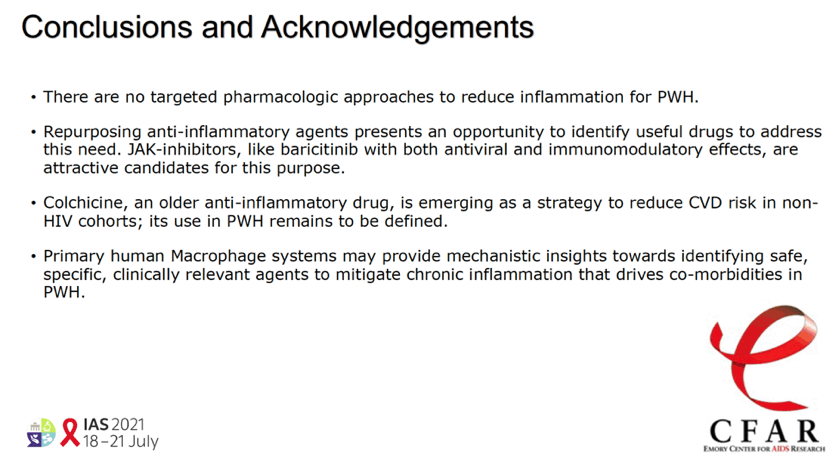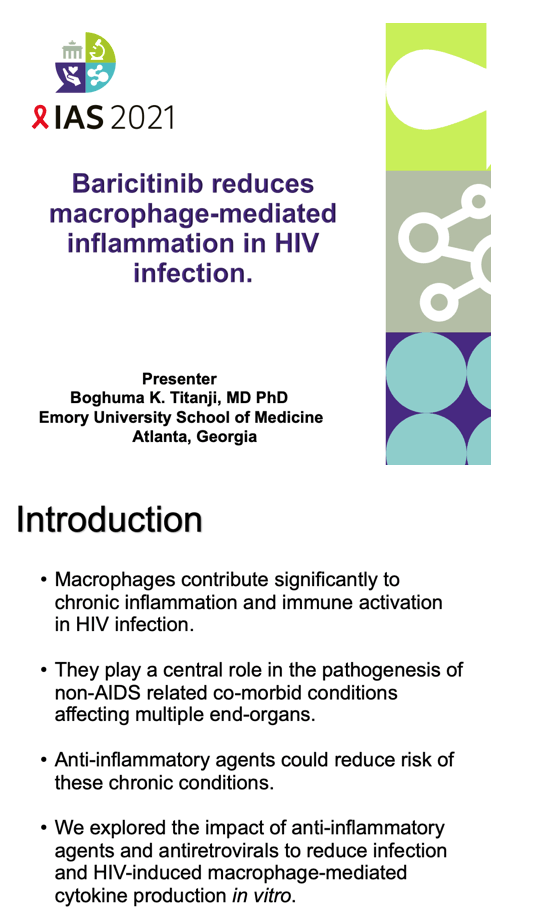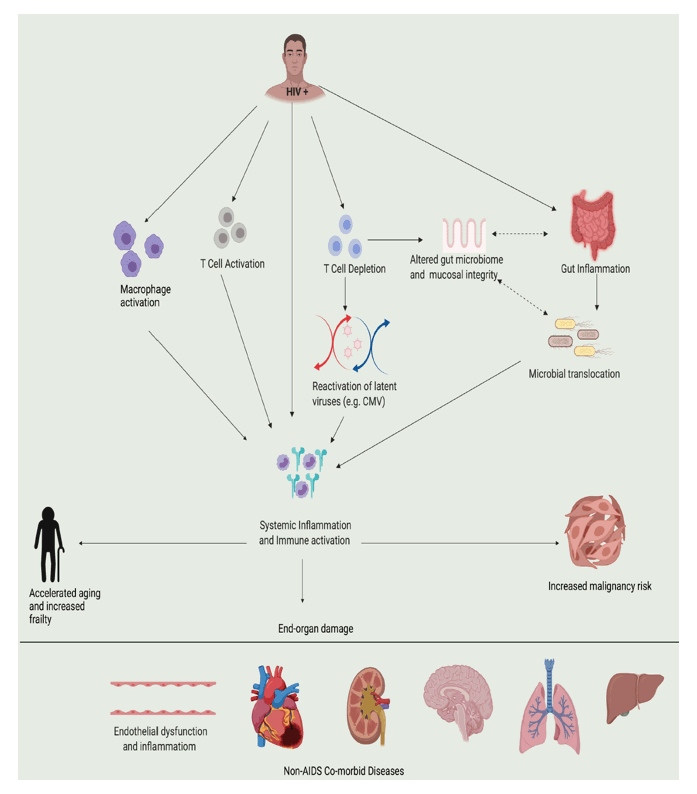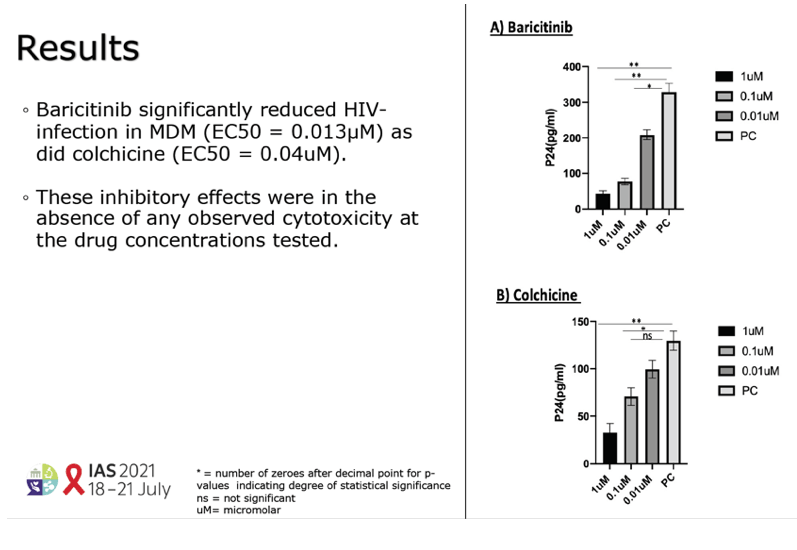 |
 |
 |
| |
Baricitinib reduces macrophage-mediated inflammation in HIV infection
|
| |
| |
Download the PDF here
IAS 2021 July 18-22
see IAS report below following the published article immediately below reporting Baricitnib reversed HAND & key events driving viral persistence.
--------------------------------------
Baricitinib reverses HIV-associated neurocognitive disorders in a SCID mouse model and reservoir seeding in vitro
A major finding of our work is that clinically relevant doses of baricitinib reverse behavioral abnormalities conferred by HIV and significantly reduce key pathological cell markers of HIVE, HIV persistence, and reservoir seeding in the CNS. These data demonstrate that baricitinib, when given systemically to HAND mice, crosses the BBB and has substantial and meaningful effects on important HAND pathological indices. Since JAK inhibitors like baricitinib inhibit mononuclear phagocyte functions and also reverse cognitive dysfunction in HAND mice, these data further link mononuclear phagocyte activation to the pathogenesis of HAND and further suggest that the HAND mouse model used in these studies is highly relevant. CONCLUSION: Our group recently reported the safety and tolerability of ruxolitinib in HIV-infected individuals [14], underscoring the potential safety and utility of JAK inhibitors for additional human trials. Our in vivo studies have shown that baricitinib, an FDA-approved JAK inhibitor, crosses the BBB and ameliorates cognitive dysfunction in HAND mice. Baricitinib treatment of HAND mice also reduces brain HIV and curtails the neuroinflammatory markers of HAND. In vitro studies showed that baricitinib significantly reduced the markers of persistence, reservoir size, and reseeding in Mφ. Given that HAND afflicts approximately 50% of cART-suppressed HIV patients, it is important to develop adjunctive, novel treatments. The data reported herein coupled with our recent human trial with JAK inhibitors provide compelling preclinical data and impetus for considering a trial of baricitinib in HAND individuals treated with cART to reverse cognitive deficits and key events driving viral persistence.
In vitro experiments in primary human Mφ demonstrated that baricitinib confers submicromolar inhibition of HIV-1 replication, HIV-induced activation, and block of reservoir establishment, maintenance, and expansion. These effects are conferred at concentrations found within the steady state in humans [26, 27] and baricitinib package insert (Olumiant.com). In addition, the data demonstrates the ability of baricitinib to reduce the number of activated murine mononuclear phagocytes (CD45/MHCII double positive cells), activated human Mφ, p24+ cells, and HIV-induced astrogliosis in the brains of HAND mice, which reflects JAK inhibition of those cells. Therefore, JAK activation in mononuclear phagocytes is associated with neurotoxicity in the presence of HIV infection. Consequently, JAK inhibitors could be used adjunctively with cART in subjects who are diagnosed to have HAND, addressing an unmet, important clinical need that is not addressed by cART alone. Data from the AIDS Clinical Trial Group using a JAK inhibitor, ruxolitinib, in HIV-infected patients on cART is currently being analyzed and should inform about safety and other potential positive effects (ClinicalTrials.gov). Our group recently reported that the ruxolitinib is safe and well-tolerated in HIV-infected, cART-suppressed individuals, with no adverse effects versus control cART group. Further, a significant reduction in sCD14, a clinical marker for monocyte activation, was observed in the ruxolitinib arm versus cART group [14]. This study is not addressing the effects of ruxolitinib on HAND. In anticipation of favorable results of ruxolitinib, our studies provide convincing impetus to consider a phase II trial of baricitinib, which is better tolerated than ruxolitinib, and provides once a day dosing, in HAND individuals on cART. We anticipate that baricitinib will improve cognitive functions, as well as HIV load and systemic inflammatory markers, in these individuals and thus represent an important step in treating a serious problem that affects 50% of HIV-infected individuals.
Abstract
Background
Since HIV-associated neurocognitive disorders (HANDs) occur in up to half of HIV-positive individuals, even with combined antiretroviral therapy (cART), adjunctive therapies are needed. Chronic CNS inflammation contributes to HAND and HIV encephalitis (HIVE). Baricitinib is a JAK 1/2 inhibitor approved in the USA, EU, and Japan for rheumatoid arthritis, demonstrating potent inhibition of IL-6, D-dimer, CRP, TNF-α, IFN-α/β, and other pro-inflammatory cytokines.
Since our previous work showed that ruxolitinib, a JAK inhibitor, ameliorates HIVE in our mouse model [8], we hypothesized that baricitinib, a once a day oral FDA-approved JAK 1/2 inhibitor, would impact these inflammatory markers without affecting immune responses necessary to control infection and would reverse cognitive deficits. Baricitinib is approved for chronic long-term use without a black-box safety label. Thus, we used our HAND model to evaluate baricitinib and to demonstrate its beneficial effect on brain inflammation and ORT. We simultaneously evaluated the effect of baricitinib on key events driving viral persistence using primary human lymphocytes and macrophages (Mφ), including HIV replication, HIV-induced activation, reservoir reseeding, and reservoir maintenance in vitro. Together, we demonstrate that baricitinib crosses the blood-brain barrier (BBB), reverses ORT abnormalities, and decreases HAND/HIVE pathological markers in a SCID mouse HAND model. Baricitinib significantly reduces markers of persistence, reservoir size, and reseeding in Mφ in vitro.
Methods
Our modified murine HAND model was used to evaluate the ability of baricitinib to cross the blood-brain barrier (BBB) and modulate monocyte/macrophage-driven HAND. Severity of HAND was measured by assessing cognitive performance of low- and high-dose baricitinib treated versus untreated HAND mice. The severity of brain neuroinflammation was evaluated in these mouse groups after flow cytometric analyses. We also assessed the ability of baricitinib to block events in myeloid and lymphoid cells in vitro that may undergird the persistence of HIV in the central nervous system (CNS) in primary human macrophages (Mφ) and lymphocytes including HIV replication, HIV-induced activation, reservoir expansion, and reservoir maintenance.
Results
In vivo, both doses of 10 and 50 mg/kg qd baricitinib crossed the BBB and reversed behavioral abnormalities conferred by HIV infection. ORT [object recognition testing] abnormalities seen in HAND mice were reversed both at 10 mg/kg and 50 mg/kg baricitinib doses (quantified on days 12 and 13, after 6 and 7 days of baricitinib treatment; Fig. 3c, d).
Moreover, baricitinib significantly reduced HIV-induced neuroinflammation marked by glial activation: activated microglia (MHCII+/CD45+) and astrogliosis (GFAP). Baricitinib also significantly reduced the percentage of p24+ human macrophages in mouse brains (p < 0.05 versus HAND mice; t test). In vitro, baricitinib significantly reduced markers of persistence, reservoir size, and reseeding in Mφ.
Cell-based antiviral potency
We sought to understand if JAK 1/2 inhibition by baricitinib could confer antiviral activity in clinically relevant cells involved in HIV persistence and activation that can promote CNS infection. Therefore, we measured the antiviral activity of baricitinib as previously described [22] in primary human Mφ and activated peripheral blood mononuclear (PBM) cells. Baricitinib demonstrated submicromolar inhibition of HIV replication in primary human Mφ and primary PBM cells (EC50/90 = 0.2 ± 0.1/2.1 ± 0.3 μM and 0.009 ± 0.003/0.4 ± 0.07 μM, respectively) (Fig. 6a).
In vitro reservoir reseeding assays
We previously demonstrated that ruxolitinib and tofacitinib block the reactivation of latent HIV from T cells [23]. This block prevents reservoir reseeding that can promote spread of the viral reservoir both within T cells and to myeloid cells and can promote activation of cells that facilitate trafficking to the CNS [8, 11, 23,24,25]. Therefore, we measured the ability of baricitinib to block reactivation of latent HIV in T cells using the J-lat system. Baricitinib blocked the TNF-α-induced reactivation of HIV-1 in a T cell line of HIV reactivation (J-lat, with an EC50/90 0.1 ± 0.08/1.1 ± 0.3 μM; Fig. 6a). Baricitinib also blocked the PMA-induced reactivation of HIV-1 from latent primary human Mφ s, with an EC50/90 0.09 ± 0.04/0.7 ± 0.1 μM, and reduced the frequency of non-dividing p24+ primary CD4+ T cells in vitro (EC50/90 0.05 ± 0.02/0.7 ± 0.08 μM; Fig. 6a). The concentrations that conferred these anti-HIV effects are within the steady-state concentration range for approved doses of baricitinib in humans (Fig. 6b) [26, 27]. Individual dose responses for data appear in Additional file 1: Figure S1.
In vitro activation marker assays
Chronic immune activation and inflammation persists even in individuals with well-controlled viremia, is a biomarker of HIV persistence, and correlates with non-AIDS-related morbidity and mortality in vivo [28, 29]. Additionally, cellular activation of T cells, monocytes, and Mφ is correlated with HAND in vivo, and HAND is driven by an HIV-induced inflammatory state that persists even in the presence of cART. To date, no existing modalities are FDA approved to treat or reverse ongoing inflammation in HIV-infected individuals. We sought to measure the effect of baricitinib on HIV-induced activation of primary human Mφ, a key cell type infected by HIV in the CNS. Baricitinib blocked the HIV-induced upregulation of activation markers HLA-DR and CD163 in primary human Mφ (EC50/90 0.1/1.2 μM; Fig. 6a, b; dose-response curves in Additional file 1: Figure S1).
Conclusion
These results show that blocking the JAK/STAT pathway reverses cognitive deficits and curtails inflammatory markers in HAND in mice. Our group recently reported safety and tolerability of ruxolitinib in HIV-infected individuals (Marconi et al., Safety, tolerability and immunologic activity of ruxolitinib added to suppressive ART, 2019), underscoring potential safety and utility of JAK inhibitors for additional human trials. The data reported herein coupled with our recent human trial with JAK inhibitors provide compelling preclinical data and impetus for considering a trial of baricitinib in HAND individuals treated with cART to reverse cognitive deficits and key events driving viral persistence.
https://jneuroinflammation.biomedcentral.com/articles/10.1186/s12974-019-1565-6
-------------------------------------
Baricitinib reduces macrophage-mediated inflammation in HIV infection
IAS 2021 July 18-22

Presenter
Boghuma Titanji
Authors
B. Titanji * (1), C. Gavegnano (2), R. Schinazi (3), V. Marconi (4).
Institutions
(1) Emory University School of Medicine, Infectious Diseases, Atlanta, United States, (2) Emory University, Pathology and Laboratory Medicine, Atlanta, United States, (3) Emory University, Pediatrics, Atlanta, United States, (4) Emory University, Infectious Diseases, Atlanta, United States
BACKGROUND: Macrophages (MΦ) contribute to chronic inflammation during HIV-infection. They play a central role in the pathogenesis of chronic inflammatory conditions such as cardiovascular disease (CVD), neurocognitive disorders and accelerated aging. These conditions disproportionately affect people with HIV (PWH). Anti-inflammatory therapy could reduce risk of these chronic conditions. We explored the impact of anti-inflammatory agents and antiretrovirals to reduce HIV-induced MΦ-mediated cytokine production in-vitro.
METHODS: Human monocyte-derived MΦ isolated from buffy coats were pretreated with baricitinib (JAK1/2 inhibitor),colchicine, or dolutegravir (DTG). Drug-treated cultures were infected with dual-tropic HIVP89.6. 5 days post-infection, MΦ supernatants were collected. Experiments were performed in quadruplicates across multiple experiments. p24 was quantified by ELISA. Multiplex cytokine profiling was performed using flow cytometry-based microbeads for IL-1β, IFN-a2, IFN-γ, TNF-a, MCP-1, IL-6, IL-8, IL-10, IL-12p70, IL-17A, IL-18, IL-23, and IL-33. Comparisons between drug-treated and non-drug treated positive control (PC) were made (paired student-t test; Prism 9).
RESULTS: Baricitinib significantly reduced HIV-infection in MΦ (EC50 = 0.013 "μM) and inhibited production of key pro-inflammatory cytokines IL-6, TNF-a, IL-1β and IL-8. Colchicine also reduced HIV-infection in MΦ (EC50 = 0.04Î1/4M), but demonstrated less broad activity in inhibiting pro-inflammatory cytokines compared to baricitinib, and instead showed inhibition only towards IL-6, TNF-a and IL-8 production. DTG did not inhibit production of pro-inflammatory cytokines in HIV-infected MΦ.
CONCLUSIONS: There are no targeted pharmacologic approaches to reduce inflammation for PWH. Repurposing anti-inflammatory agents presents an opportunity to identify useful drugs to address this need. JAK-inhibitors, like baricitinib with both antiviral and immunomodulatory effects, are attractive candidates for this purpose. Colchicine, an older anti-inflammatory drug, is emerging as a strategy to reduce CVD risk in non-HIV cohorts; its use in PWH remains to be defined. Primary human MΦ systems may provide mechanistic insights towards identifying safe, specific, clinically relevant agents to mitigate chronic inflammation that drives co-morbidities in PWH.




|
| |
|
 |
 |
|
|